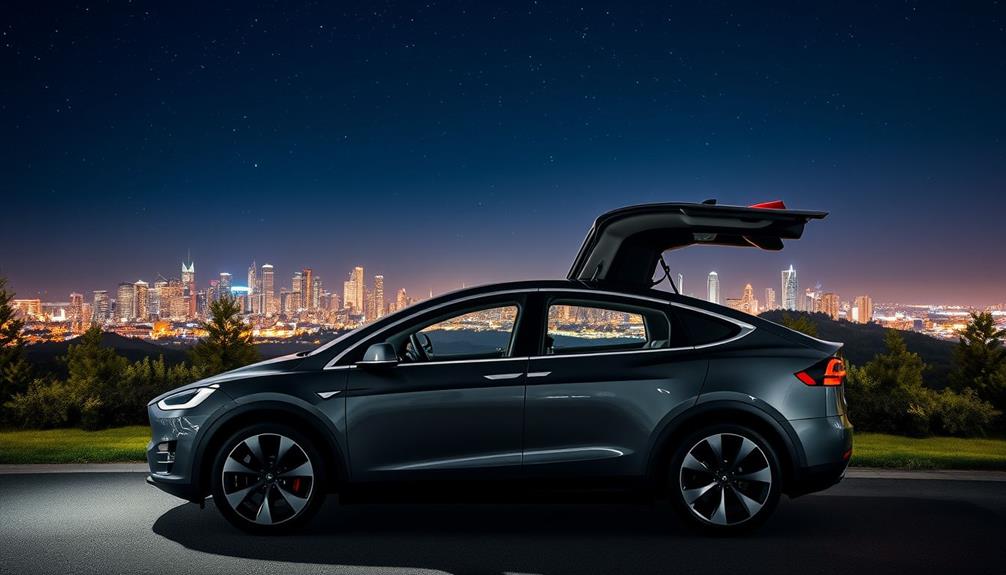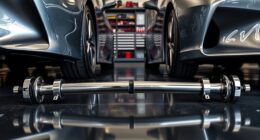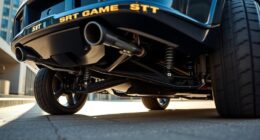Nikola Tesla, born on July 10, 1856, was a brilliant inventor and electrical engineer who changed the world with his work in alternating current (AC) technology. You might know him for his contributions to modern electricity, including the Tesla coil and the AC induction motor. After an early career marked by disputes with Thomas Edison, he showcased the superiority of AC at the 1893 World's Columbian Exposition. Despite facing financial struggles and competition, his innovations laid the groundwork for our contemporary electrical systems. There's so much more to his incredible journey that you'll find fascinating!
Key Takeaways
- Nikola Tesla was a Serbian-American inventor born on July 10, 1856, known for developing the alternating current (AC) power system.
- He worked for Edison Machine Works but resigned due to disputes over AC vs. DC technology and financial disagreements.
- Tesla patented the AC induction motor in 1888, revolutionizing electrical engineering and enabling self-starting electric motors.
- He created the Tesla coil in 1891, which became essential for wireless communication and radio transmission.
- Tesla held over 300 patents and his legacy endures through the SI unit "tesla," symbolizing his impact on technology.
Early Life and Education

Nikola Tesla's early life was marked by a unique blend of cultural influences and intellectual prowess. Born on July 10, 1856, in Smiljan within the Austrian Empire, he was raised in a Serbian Orthodox family, which instilled in him a deep appreciation for education and innovation.
From a young age, you'd notice his eidetic memory, enabling him to visualize complex concepts and inventions in remarkable detail. In pursuit of knowledge, he attended primary school in Smiljan before moving to Gospić for further studies.
By 1873, you'd see him graduate high school with a strong focus on mathematics and physics. His passion for these subjects led him to the Polytechnic Institute in Graz, Austria, where he began studying engineering and physics on a scholarship.
However, despite his brilliance, he faced academic struggles and left without completing his degree. After departing Graz in December 1878, Tesla worked as a draftsman in Maribor, earning 60 florins a month.
This experience fueled his growing interest in electrical engineering, setting the stage for a remarkable career that would transform the world.
Career Beginnings

You'll find that Nikola Tesla's career took off in 1881 at the Budapest Telephone Exchange, where he first honed his skills in electrical engineering.
Just a few years later, he moved to the United States and joined Edison Machine Works, aiming to improve electrical systems.
However, his time there was short-lived due to conflicts with Edison, setting the stage for his future innovations.
Early Employment Opportunities
Starting his career at the Budapest Telephone Exchange in 1881, Tesla developed a strong interest in electrical engineering and telephony.
In 1882, he moved to Paris to work for the Continental Edison Company, where he gained practical experience in electric lighting and systems. This opportunity allowed him to deepen his understanding of electrical technologies, setting the stage for his future innovations.
In June 1884, Nikola Tesla emigrated to the United States and joined Edison Machine Works in New York City. Here, he faced a competitive environment that challenged his skills and ideas.
Despite his talent, Tesla's time at Edison was marked by unresolved bonus disputes and differing views on technology, particularly regarding the merits of AC systems versus Edison's preferred DC systems.
After a brief tenure, Tesla resigned from Edison Machine Works, determined to pursue his vision independently.
In 1885, he sought investors and founded the Tesla Electric Light Company. This marked the beginning of his journey into independent inventions, paving the way for groundbreaking advancements in electrical engineering that would soon follow.
Edison Collaboration Experience
After establishing his foundation in electrical engineering, Tesla's move to the United States brought him to Edison Machine Works in New York City. Here, he honed his advanced engineering skills, quickly catching Edison's attention with his talent for designing improved dynamos and motors.
This collaboration, however, lasted only six months. Tesla and Edison had differing business philosophies, and unresolved disputes over promised bonuses soured their working relationship.
During his time at Edison, Tesla developed an innovative arc lamp-based street lighting system, but unfortunately, his designs never saw production. Frustrated by this lack of recognition and opportunity, he decided to resign and seek better prospects.
This pivotal moment marked the beginning of Tesla's journey towards independence in the engineering world.
After leaving Edison, Tesla sought investors for his groundbreaking ideas, which ultimately led to the creation of the AC induction motor. This innovation would spark a fierce rivalry with Edison's direct current system, setting the stage for one of the most significant battles in electrical engineering history.
Tesla's experiences at Edison Machine Works were essential in shaping his future endeavors and revolutionary contributions.
Innovations and Inventions

Nikola Tesla's groundbreaking innovations and inventions have fundamentally shaped modern technology and electrical systems. As an inventor, Nikola Tesla revolutionized the way we generate and use electricity. His contributions aren't just historical; they're the backbone of today's electrical infrastructure.
Here are some key innovations:
- Developed the AC electricity system, which is now the global standard.
- Patented the polyphase induction motor in 1888, allowing for self-starting electric motors.
- Created the Tesla coil, essential for wireless communication and radio transmission.
- Designed one of the first AC hydroelectric power plants at Niagara Falls.
These inventions illustrate Tesla's genius. His AC electricity system not only transformed electrical circuits but also enabled large-scale power generation through hydroelectric power. The polyphase induction motor made electric drives more efficient, while the Tesla coil paved the way for advancements in wireless technology.
With over 300 patents, Tesla's work in radar, X-ray technology, and remote control systems further cements his legacy as a visionary. His contributions continue to influence how we live and connect today, proving that the spirit of innovation remains alive through his work.
Work With Edison

Tesla's brief but impactful time at Edison Machine Works marked a significant turning point in his career. When Nikola Tesla arrived in the United States in 1884, he was enthusiastic to work under Thomas Edison, focusing on improving electric systems and electrical equipment.
During his six months there, he developed an innovative arc lamp-based street lighting system, but Edison showed little interest in bringing Tesla's designs to life. Frustrated by ongoing disputes over bonuses and their differing approaches to electrical systems, Tesla eventually resigned.
This decision led him to seek investors for his own projects, igniting a fierce rivalry between him and Edison. While Edison championed direct current (DC), Tesla's vision was firmly rooted in alternating current (AC) technology.
Though their paths diverged, Tesla's experience at Edison laid the groundwork for his future innovations, particularly in AC motors. This period not only showcased Tesla's brilliance but also highlighted the stark contrasts between the two inventors' philosophies and methods.
Ultimately, his time at Edison was a catalyst for Tesla's groundbreaking contributions to the electrical industry, setting the stage for the challenges that would define his later career.
The Battle of Currents

In the late 19th century, a fierce rivalry emerged between Thomas Edison's direct current (DC) system and the alternating current (AC) technology championed by Tesla and George Westinghouse. The Battle of Currents wasn't just a technical dispute; it was a battle for the future of electrical power distribution in the United States.
- Edison touted his DC system as safer.
- Tesla and Westinghouse argued that AC electricity could be transmitted over longer distances more efficiently.
- Tesla showcased AC at the 1893 World's Columbian Exposition in Chicago, influencing public opinion.
- Edison resorted to negative tactics, even electrocuting animals to depict AC as dangerous.
Despite Edison's efforts to sway public perception, Tesla's AC system ultimately prevailed. This victory led to the widespread adoption of AC as the standard for electrical power transmission, paving the way for modern electrical grids.
Tesla's innovations revolutionized how electricity is distributed, making it more accessible and efficient. The Battle of Currents not only defined the electrical landscape of the time but also solidified Tesla's legacy as a pioneer in electrical engineering.
Later Achievements

Following his groundbreaking work in the Battle of Currents, Tesla continued to push the boundaries of electrical engineering with a series of remarkable achievements. One of his most notable contributions was the development of the alternating current (AC) power system, which became the global standard for power transmission in the 20th century.
In 1891, Nikola Tesla invented the Tesla coil, a resonant transformer circuit that produces high-voltage, low-current electricity, laying the groundwork for modern wireless transmission technologies.
In 1895, he designed one of the first AC hydroelectric power plants at Niagara Falls, which greatly contributed to the development of power systems. His innovative work with high-voltage transmission transformed the way electricity was generated and distributed.
Additionally, Tesla's ambitious Wardenclyffe Tower project aimed to achieve wireless transmission of electricity, facilitating global communication and redefining connectivity.
Over his lifetime, Tesla held more than 300 patents, showcasing his pioneering spirit and contributions to various fields, including radar and X-ray technology. His inventions continue to influence modern technology, proving that Tesla's vision extended far beyond his time.
Financial Struggles

You might be surprised to learn that Nikola Tesla's groundbreaking inventions often came at a steep financial price.
As market competition intensified, he struggled to secure the investor support necessary for his innovations.
Despite his brilliance, these financial challenges ultimately hindered his work and recognition in the field.
Market Competition Challenges
Amid fierce competition in the late 1880s, Nikola Tesla encountered significant financial struggles that hindered his groundbreaking work. Competing against established giants like Edison Electric and Westinghouse Electric, Tesla's efforts to promote his AC system faced numerous hurdles.
Westinghouse Electric initially supported Tesla's innovations, but following the panic of 1890, their financial difficulties limited investment opportunities. To keep their partnership alive, Tesla made a tough decision to release Westinghouse from royalty payments, which further strained his finances.
In 1895, he founded the Nikola Tesla Company to secure funding for his patents, but attracting investors during such a challenging financial period proved difficult.
Here are some key challenges he faced:
- Intense competition from established firms like Edison Electric
- Westinghouse Electric's financial woes impacting support
- Struggles to attract investors for his revolutionary ideas
- Incomplete projects, including the Wardenclyffe Tower for wireless power
Ultimately, Tesla's financial struggles and market competition left him with limited resources, stalling many of his ambitious projects that could have changed the world.
Investor Support Issues
Frequently, investor support proved elusive for Nikola Tesla, greatly hampering his progress. After initial successes, Tesla faced considerable financial struggles, especially as competition intensified with giants like Edison and Westinghouse.
Although he secured a licensing deal with Westinghouse for his AC induction motor, his financial situation took a turn for the worse when Westinghouse encountered its own economic challenges in the early 1890s.
To help maintain support, Tesla agreed to relieve Westinghouse of royalty payments, but this decision further strained his already limited resources. In 1895, he founded the Nikola Tesla Company in hopes of attracting investors for his groundbreaking innovations.
Unfortunately, during these financially challenging times, he struggled to gain the necessary backing, which severely limited his ability to pursue new projects.
As a result, Tesla's innovations often went overshadowed by investor support issues. He faced periods of obscurity and underfunding, even as his inventions laid the groundwork for modern electrical systems.
Ultimately, despite his brilliance, financial struggles consistently plagued Nikola Tesla, considerably impacting his legacy and the recognition he deserved.
Legacy and Impact

Nikola Tesla's legacy is a demonstration of his profound impact on modern technology and energy systems. His work laid the foundation for advancements that continue to shape our world today. You can appreciate his contributions through several key areas:
- The development of the AC motor, which revolutionized power systems.
- The invention of the Tesla coil, essential for wireless communication technologies.
- His role in designing the first AC hydroelectric power plant at Niagara Falls, showcasing the potential of renewable energy.
- Over 300 patents in various technologies, from radar to remote control, highlighting his diverse influence on electrical engineering.
Tesla's innovations not only transformed how we harness and distribute power but also inspired ongoing advancements in renewable energy and technology.
His name lives on in the SI unit of magnetic flux density, the "tesla," established in 1960. As you explore the domains of electrical engineering today, you'll find Tesla's influence is ever-present, reminding you of the genius who dared to dream beyond the conventions of his time.
Tesla's legacy is a tribute to creativity and innovation that continues to inspire future generations.
Frequently Asked Questions
Who Is the Real Tesla Guy?
The real Tesla guy's a visionary inventor who revolutionized electrical engineering. He developed the alternating current system and created groundbreaking technologies, making significant contributions to modern electricity and wireless communication that you still benefit from today.
Who Is Nikola Tesla Named After?
You're likely asking who Nikola Tesla is named after. It's actually Nikola Tesla himself, the inventor known for his groundbreaking work in electricity and electromagnetism, which laid the foundation for much of modern electrical engineering and technology.
What Was Tesla's Cause of Death?
When the clock struck fate, Tesla succumbed to coronary thrombosis, a silent thief stealing his heartbeat. In a dim hotel room, solitude enveloped him as he departed, largely forgotten, yet a spark of genius ignited his legacy.
Is Nikola Tesla Related to Elon Musk?
No, Nikola Tesla isn't related to Elon Musk. While Musk named his company after Tesla to honor his innovations, they belong to different eras and fields, with Tesla's work laying the groundwork for modern electrical systems.
Conclusion
In the grand tapestry of invention, Nikola Tesla stands as a lighthouse, guiding lost ships through stormy seas of ignorance. His brilliance illuminated paths once shrouded in darkness, sparking revolutions that still resonate today. Though he faced fierce tempests of financial struggle, his spirit soared like a phoenix, leaving an indelible mark on humanity. As you embrace your own journey, remember Tesla's flame; it's a reminder that innovation often requires perseverance against the fiercest winds.










